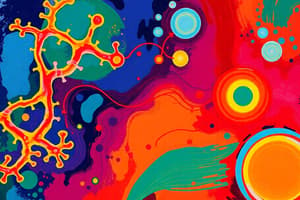Podcast
Questions and Answers
What is the role of cofactors in enzyme activity?
What is the role of cofactors in enzyme activity?
- They are always proteins that enhance enzyme function.
- They are only required for certain enzymes and assist in specific chemical processes. (correct)
- They are products of enzymatic reactions that help catalyze further reactions.
- They inhibit enzyme activity by binding to the active site.
Which of the following best describes catabolic pathways?
Which of the following best describes catabolic pathways?
- They release stored energy by breaking down complex molecules. (correct)
- They store energy in the form of complex carbohydrates.
- They involve the synthesis of biomolecules like proteins.
- They build complex molecules from simpler ones.
In a redox reaction, what does oxidation refer to?
In a redox reaction, what does oxidation refer to?
- The conversion of pyruvate to acetyl CoA.
- The addition of electrons to a substance.
- The loss of electrons from a substance. (correct)
- The breaking down of organic molecules.
What occurs when an enzyme's product also acts as an inhibitor?
What occurs when an enzyme's product also acts as an inhibitor?
What is the end product of glycolysis?
What is the end product of glycolysis?
What role does ATP play in cellular work?
What role does ATP play in cellular work?
What is the function of enzymes in metabolic reactions?
What is the function of enzymes in metabolic reactions?
What is the significance of the active site in an enzyme?
What is the significance of the active site in an enzyme?
What happens during ATP hydrolysis?
What happens during ATP hydrolysis?
Which statement accurately describes catabolic pathways?
Which statement accurately describes catabolic pathways?
How is ADP phosphorylated to regenerate ATP?
How is ADP phosphorylated to regenerate ATP?
What is the free energy of activation?
What is the free energy of activation?
What is the outcome when pyruvate is oxidized?
What is the outcome when pyruvate is oxidized?
What is another name for the citric acid cycle?
What is another name for the citric acid cycle?
What role do dehydrogenases play in the citric acid cycle?
What role do dehydrogenases play in the citric acid cycle?
Where does the accumulation of protons occur in the mitochondria during the electron transport chain?
Where does the accumulation of protons occur in the mitochondria during the electron transport chain?
What is the main function of ATP synthase in cellular respiration?
What is the main function of ATP synthase in cellular respiration?
Which of the following statements is true regarding the citric acid cycle's energy yield?
Which of the following statements is true regarding the citric acid cycle's energy yield?
How do electrons move through the electron transport chain?
How do electrons move through the electron transport chain?
What is the significance of the ion gradient created by ATP synthase?
What is the significance of the ion gradient created by ATP synthase?
Which pathway occurs after pyruvate is oxidized?
Which pathway occurs after pyruvate is oxidized?
Flashcards are hidden until you start studying
Study Notes
ATP powers cellular work
- ATP (adenosine triphosphate) is the primary energy currency of cells.
- ATP contains a sugar (ribose), a nitrogenous base (adenine), and a chain of three phosphate groups.
- The bonds between the phosphate groups are broken by hydrolysis, releasing energy.
- This energy is harnessed by proteins to perform cellular work:
- Chemical work: synthesizing molecules
- Transport work: pumping substances across membranes
- Mechanical work: powering muscle contraction, cilia, and flagella movement.
- ATP is a renewable resource, regenerated by adding a phosphate to ADP (adenosine diphosphate) using energy from catabolic reactions.
Enzymes lower energy barriers
- Enzymes speed up metabolic reactions by lowering the activation energy required for the reaction to occur.
- Enzymes are catalysts that are not consumed in the reaction.
- The substrate (reactant) binds to the enzyme's active site, a specific region with a shape that complements the substrate.
- After the reaction at the active site, the product is released, and the enzyme is available for another substrate molecule.
- Many enzymes require non-protein cofactors, such as coenzymes, to function properly.
- Enzyme inhibitors can block enzyme activity, either competitively (competing with the substrate for the active site) or non-competitively (binding to a different site on the enzyme, altering its shape).
Catabolic pathways yield energy
- Catabolic pathways release energy by breaking down complex molecules into simpler ones.
- A key process in catabolism is oxidation-reduction (redox) reactions.
- Oxidation: loss of electrons from a substance.
- Reduction: gain of electrons by a substance.
Glycolysis
- Glycolysis is the first stage of cellular respiration.
- It occurs in the cytosol, breaking down glucose into two pyruvate molecules.
- The process involves ten steps, with some requiring ATP input and others producing ATP and NADH (reduced form of NAD+ coenzyme).
- Glycolysis yields a net gain of 2 ATP and 2 NADH per glucose molecule.
The Citric Acid Cycle
- After pyruvate is oxidized to acetyl CoA, the citric acid cycle completes the breakdown of glucose.
- The cycle takes place in the mitochondrial matrix.
- It involves a series of eight steps, producing NADH, FADH2 (reduced form of FAD coenzyme), and ATP.
- The cycle generates 2 ATP, 6 NADH, and 2 FADH2 per glucose molecule.
Oxidative Phosphorylation
- This is the final stage of cellular respiration, generating the majority of ATP.
- It occurs in the inner mitochondrial membrane.
- The electron transport chain uses the energy from electrons carried by NADH and FADH2 to pump protons across the inner mitochondrial membrane.
- This creates a proton gradient, which is harnessed by ATP synthase to produce ATP through chemiosmosis.
- Oxidative phosphorylation produces approximately 34 ATP per glucose molecule.
Studying That Suits You
Use AI to generate personalized quizzes and flashcards to suit your learning preferences.




